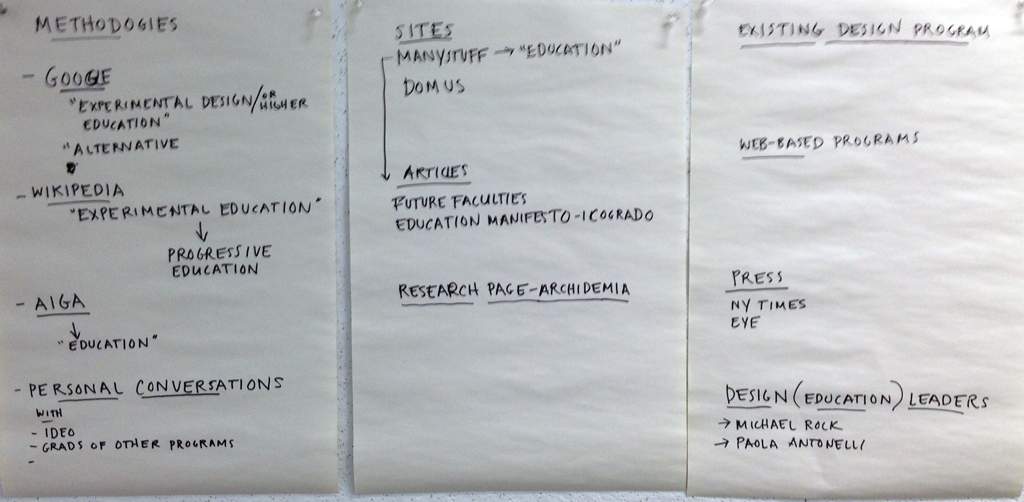SEARCH METHODOLOGIES

PDFs
DR Experimental
LS Experimental
CR Experimental
LISTS
New Design Ed Approaches/Curriculums
New Design Specializations
- Research in Art & Design
- Pratt Programs
- SVA Products of Design – MFA
- Interdisciplinary Design Practice
- MA Applied Craft & Design
- Information Design – Eindhoven
- Social Design- Eindhoven
- Master in Design Studies
- Post Graduate Research Program
- Digital Humanities – UCLA. Undergrad Minor. Grad Certificate
Experimental Programs
- School of Missing Studies
- Historical Experimental Programs
- Think Tank for Visual Strategies
- Dirty Art Dept – Sandberg
- Contextual Design – Sandberg
- Thought Experiments in GD Ed book
- Books from the Future
- Sundown Schoolhouse
- D-School
Design PhDs
- PhD in visual art and design – Leiden
New Institutions
Shifting Design Programs (BFA or MFA?)
SAIC: School of the Art Institute of Chicago
- Rise of MultiDisciplinary Design
- Ask any student or faculty member about interior design education today and invariably you’ll hear about interdisciplinary collaboration
- —the merging of specialties
- —and professional interaction and experience.
- Students want real world experiences.
- The time for specialists has passed, and the job market of today is demanding people with unique combinations of skill sets and experiences
SCAD: Savannah College of Art and Design
- Interdisciplinary Collaboration Studios
- Interdisciplinary collaborative studios enable students from various departments from around the university to engage in design thinking and creative problem solving
- These academic exercises prepare students to enter the work force ready to lead or contribute as a team member in real world,collaborative settings
The University of Cincinnati
- Interdisciplinary Collaboration
- Reevaluation of curriculum design found at the School rather than individual Program level
- Switched to the Semester system in 2012
- Each semester is conceptually divided: form, semiotics, content, exploration, research, usability, synthesis
- 6th semester course block unifies interdiciplinaruy collaboration and solves logistical problem of
- differing class times and schedules throughout different disciplines
Carnegie Mellon: School of Design, Mechanical Engineering, School of Business
- Inter School Collaboration requirement
- One of a few programs that are placing an emphasis on the relationship between business and design
- Learning management through terms of design problem solving
California College of the Arts
- “Smart SPaces for Learning” Course
- Unites students from multple programs to designers who see space as a element and designers
- who see record as a element to redefine classrooms with new forms of spatial, material, virtual, and human/computer interaction.
- Encourages reevaluation of theory of design/ incorporates progress of technology
North Carolina State University
- Students learn to be critical users
- Teaches students to resolve tech issues not before a problem with traditional medium (ex. difference between reading a publication on a screen vs. print)
- designed to teach student how to anticipate different behaviors from readers
- Carnegie Mellon: 1st Year Drawing and Visualization Studio
- Takes students from basic drawing to animation
- Demonstrates how to see form through use of different tools and how tech can be used in the future
Dave Malouf
- calls for accesability to resources
- redesign of the apprenticeship model
- balance between formal and informal learning to accommodate incfreased need for communication between communities
- discusses the need for the designer to become a reinvented rennaissance entity
- 1. We cannot relinquish the craft of making forms as part of the designer’s role at the executive and at the strategic level.
- 2. Technology has accelerated cultural complexity forcing us to examine relationships between use, consumption, social behaviour and individual meaning.
- 3. With these changes, come complex environmental, political and economic challenges that we cannot ignore.
- 4. We must rebuild the apprenticeship model from early preindustrial applied arts in order to supplement lifelong design education.
Rethinking Education
No Right Brain Left Behind: Group that is rethinking creativity in education. Headed by Sir Ken Robinson.
Research Resources
“Design Education of the Future,” ICOGRADA IDA. Malouf, Dave. 2011
“World’s Best Design Schools,” Bloomberg Businessweek. Wong, Vanessa. 30 September 2009
“Future of Design Education: Teaching Innovation,” Interior Design. Pepitone, Sara. 1 July 2013.
School at the Art Institute of Chicago: The Rise of Multidisciplinary Design. InteriorDesign.com.Pepitone, Sara. 22 July 2013.
California College of the Arts: Working For and Around New Technologies. InteriorDesign.com. Pepitone, Sara. 22 July 2013.
The Future of Design and Design Education: Strategies for assessing the responsiveness of design programs to the context of practice,” Monzel Hughs, Karen; Anderson, Eric; Davis, Meredith; King Roth, Susan; Weightman, David. October 2011.
TAGGED RESEARCH (Tage indicates nature of interest)




Here’s the assignment due for Tuesday, September 24. Please forward notification of this comment to me at sandhaus@calarts.edu. That way I’ll know that you’re receiving posts and comments on our site. Thanks!